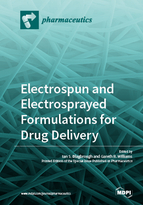Electrospun and Electrosprayed Formulations for Drug Delivery
A special issue of Pharmaceutics (ISSN 1999-4923).
Deadline for manuscript submissions: closed (30 November 2018) | Viewed by 63343
Special Issue Editors
Interests: pharmaceutical analysis; natural products; electrospinning; electrospraying; biopolymers; coaxial; controlled drug delivery; nanofiber; polymer therapeutics; sustained release; tissue engineering; wound healing; biodegradable; gene therapy; polycaprolactone; drug metabolism and phytochemistry
Special Issues, Collections and Topics in MDPI journals
Interests: drug delivery; vaccines; nanomaterials; formulation science
Special Issues, Collections and Topics in MDPI journals
Special Issue Information
Dear Colleagues,
Electrospinning and spraying have been widely explored to prepare drug delivery systems. In this research, it is important to demonstrate the biocompatibility of the electrospun matrices and to investigate the biological activity of the delivered drug or growth factor. The latter must be maintained and the drug delivered in a controlled manner to prepare potent new medicines. Sustained and controlled release of active pharmaceutical ingredients (API) from drug-loaded electrospun matrices can be achieved, with systems composed of biopolymers or biocompatible synthetic polymers found to demonstrate compatibility with human cells as well as significant biological activity.
Investigations of a wide range of polymers and their blends have been undertaken in order to produce advanced materials, potentially displaying superior rheological and viscoelastic properties over other polymers. Different electrospinning techniques allow for the loading of a range of drugs with high encapsulation efficiencies. The potential applications of electrospun nanofibres include drug delivery in research areas as diverse as anti-cancer therapeutics, gene therapy, and wound healing, as post-surgical abdominal anti-adhesion products, and for tissue engineering. Electrospun nanofibres have a large surface area and can mimic the topographical features of extracellular matrices (ECM). Materials with such properties are potentially useful for the much-needed production of bioactive scaffolds, combining the controlled release of a wide variety of therapeutically active agents (e.g. antibiotics, anti-cancer drugs, growth factors, DNA) with a nanofibrous scaffold which will support cell proliferation (e.g. in tissue engineering) or prevent cell migration. With controlled release of the entrapped API and models available both in vitro and in vivo to establish viability in target cells, successful drug delivery can be quantified and cell morphology and pathology assessed, especially aiming for minimal off-target effects.
The simplest electrospun drug delivery system is comprised of only a blend of polymer and drug. However, more advanced materials such as double- and triple-layered fibrous dressings and implants can be produced by electrospinning, representing a significant shift in how we view drug delivery technology.
Despite their great promise, there is more research still to be done before these formulations can be taken forward into the clinic. The controlled release profiles of electrospun matrices and their biocompatibility need to be clearly established.
This special issue of Pharmaceutics has a clear focus on research in these important areas.
Dr Ian S. Blagbrough
Dr Gareth R. Williams
Guest Editors
Manuscript Submission Information
Manuscripts should be submitted online at www.mdpi.com by registering and logging in to this website. Once you are registered, click here to go to the submission form. Manuscripts can be submitted until the deadline. All submissions that pass pre-check are peer-reviewed. Accepted papers will be published continuously in the journal (as soon as accepted) and will be listed together on the special issue website. Research articles, review articles as well as short communications are invited. For planned papers, a title and short abstract (about 100 words) can be sent to the Editorial Office for announcement on this website.
Submitted manuscripts should not have been published previously, nor be under consideration for publication elsewhere (except conference proceedings papers). All manuscripts are thoroughly refereed through a single-blind peer-review process. A guide for authors and other relevant information for submission of manuscripts is available on the Instructions for Authors page. Pharmaceutics is an international peer-reviewed open access monthly journal published by MDPI.
Please visit the Instructions for Authors page before submitting a manuscript. The Article Processing Charge (APC) for publication in this open access journal is 2900 CHF (Swiss Francs). Submitted papers should be well formatted and use good English. Authors may use MDPI's English editing service prior to publication or during author revisions.
Keywords
- Electrospinning
- Electrohydrodynamic
- Controlled release
- Polymer formulations
- Biopolymer formulations








